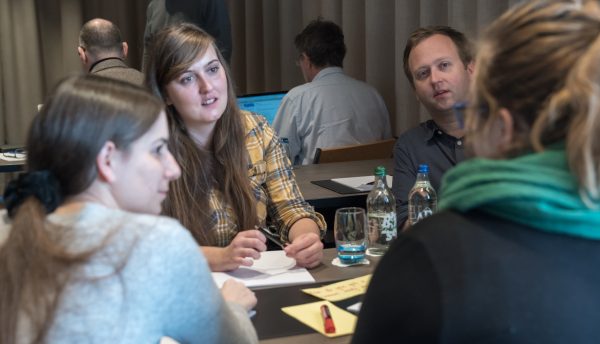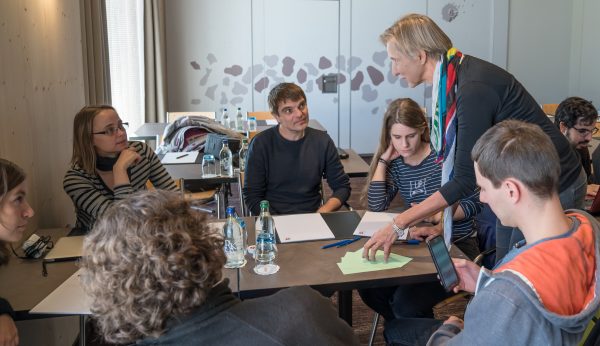From sand castles to cool freaks

In the three communication workshops at the PlanetS general assembly researchers discussed in groups about possible media releases and presented very creative summaries. Most of the proposed stories will be realized and published in the next weeks or months either as press releases, PlanetS news or articles in our external newsletter “The Observer”.

Participants of the communication workshop discussed about topics for a media release. (Photo: Sylviane Blum)

Explaining how you get a camera ready for space. (Photo: Sylviane Blum)

Getting ready for the presentation. (Photo: Sylviane Blum)
«Tiny star», «Tiny star bullies a planet», «Discovery of the “coolest” object of the Universe?», «Cool freaks in the desert»: These were the titles of the presentations of four different groups of researchers during the communication workshop in Grindelwald. Although the twelve teams had formed quite randomly and worked independently, four of them chose the same scientific paper for a possible media release. Anthony Cheetham, leading author of the paper, had presented his scientific results the day before, during the splinter session 3 about atmospheres, surfaces and interiors, and obviously impressed his colleagues. Maybe there was also a strong support by the co-authors – 6 out of 9 are members of PlanetS.
The paper is still in the review process but it will certainly make a very interesting story as soon as it is accepted, probably late February or March. The summaries provided by the four groups as well as Anthony Cheethams additional explanations and graphics are excellent and fun to read. They will serve as a perfect basis for a text targeted at non-experts.
Great illustrations and comparisons
«Observing the building of alien worlds?» and «Born to be planets» were two headlines proposed that also addressed one topic, a scientific paper by Henning Avenhaus. It features stunning images, what makes it particularly appealing to a general public. In the workshop both groups that chose this topic made an excellent summary of what is new and why this is important, but since the paper isn’t ready yet, we currently won’t reveal more details.
The advice to use comparisons and associations was realized by many teams in a very creative way. One team reported about «Four giants who started small», whereas another one presented a sketch with a scale balancing Venus against an exoplanet five times heavier and stating that this super-Venus is «probably uninhabitable due to its 700 K surface temperatures, enough to melt lead. «Building planets as sand castles», was the headline of a group that also asked: «Is water the glue that helped to form planets?” And another team described «Sunbathing meteoroids»: «Just as you can tell where your friend spent his holidays based on the tan of his skin, scientists can tell where and for how long meteorites travelled in space», the group reported. These papers are still in preparation and will be covered once they are accepted.
Among the stories that got most votes by the participants was «How do you get a camera ready for space?». We plan to tell more about it in summer when this paper by Victoria Roloff will be published. Another winner was: «Birth of the Moon». The team’s very promising summary stated: «A great collaboration between the Swiss universities could determine the birth date of the moon. They solved the mystery of the similarity between the Earth and the Moon.This changes fundamentally the understanding of the evolutionary conditions for life on the Earth.» The paper is in progress and of course, we are very curious.
Barbara Vonarburg
PS: Thanks again to everybody who attended the communication workshop. Please feel free to contact us anytime if you have an interesting research result that we can report about.
Barbara.vonarburg@space.unibe.ch
Guido.schwarz@space.unibe.ch
Pierre.Bratschi@unige.ch
Presentation “How to get the media interested in your scientific papers”
Categories: Internal Newsletter
